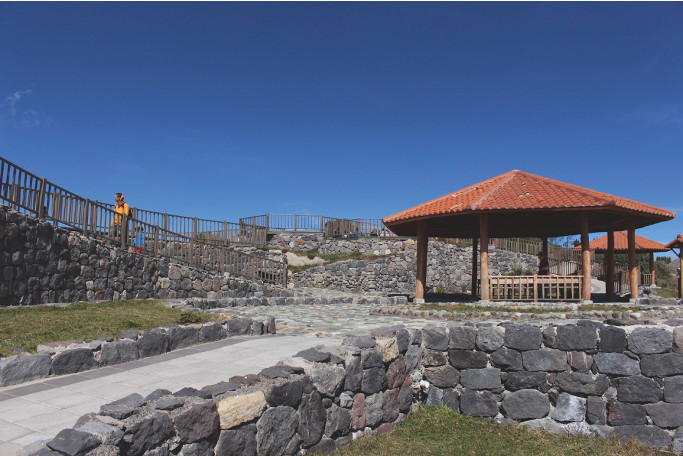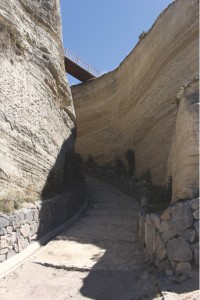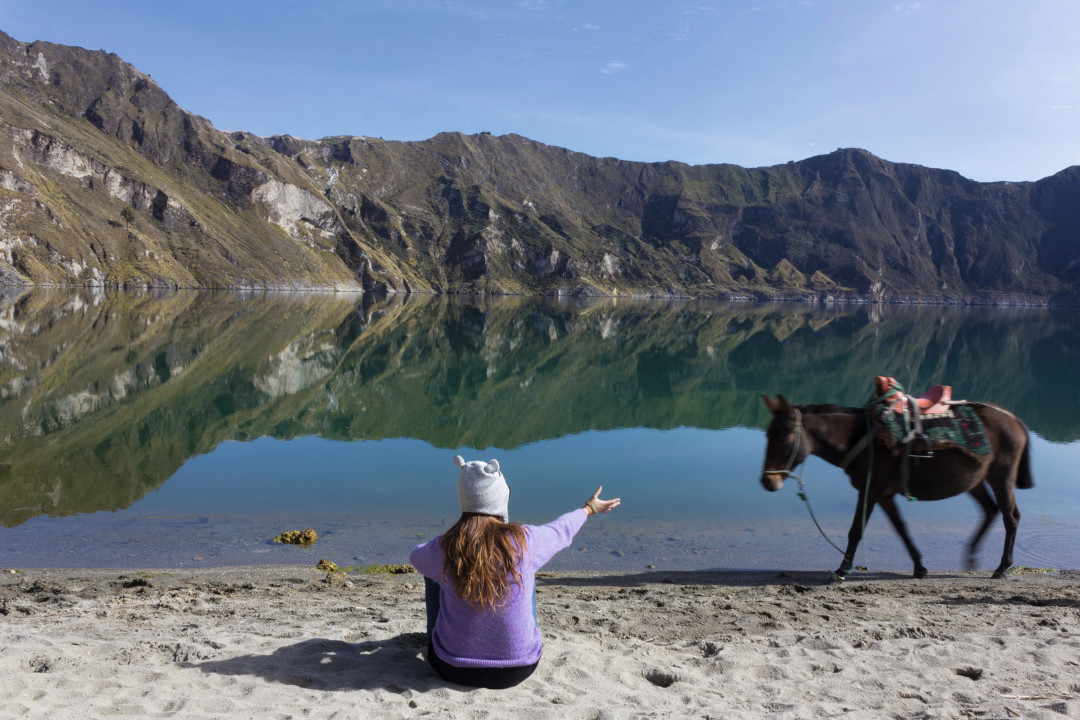A lagoon inside a volcano
Tourist can enjoy horseback rides, walks along the Playita path, kayaking, camping, hiking and trekking. You can also visit the local gallery and be delighted by de food and shelter
The Quilotoa lagoon is one of those places that’s known by word of mouth. It’s remembered by all visitors, local and foreign, which is not a surprise. This is a place that promotes itself!
The visitor’s first impression is the sheer magnitude of the volcano, particularly when viewed from inside the crater. But, what really leaves visitors quite speechless is the color of the lagoon. It’s a deep emerald green, switching to bluish green or turquoise green, according to the season.
The word Quilotoa comes from two sources: the kichwa indian term “kiru” that means tooth and “toa” that means princess, that is, the “princess tooth”. It’s believed that this name is due to its nearly elliptical shape. This volcano is potentially active. Eight major eruptions have taken place over the last two hundred thousand years.
The lagoon is in a crater formed during its last eruption about 800 years ago. It’s located in Cotopaxi province, some 97 miles south of Quito, the capital city, part of the Andes mountain range and inside the Illinizas ecological reserve.
The lagoon has a surface area of 1.4 square miles and it lies about 0.3 miles below the rim of the crater. The crater’s diameter is about 3.7 miles.
Sometimes, certain sectors of the lagoon turn yellow such that it looks like boiling water. This is due to an increase in gases, particularly CO2 mixed with sulfurous hydrogen. Obviously, human consumption is not recommended. The water’s temperature ranges between 30 and 60 degrees Fahrenheit. As to the lagoon’s depth, there are differing opinions. Some nearby villagers claim it’s some thirteen hundred feet deep while others affirm it’s quite shallow.
How to arrive?
Entrance to the lagoon is through the Quilotoa community. The ticket costs $2 dollars per person
Entrance to the lagoon is through the Quilotoa community. The ticket costs $2 per person, including parking lot, bathroom services, information on “Citur“, a visit to the handicrafts shops next to the parking lot. Even at a distance, the volcano is a gorgeous sight. However, only when you approach the rim, near the overlook, can its true splendor be properly appreciated. The downhill walk to the lagoon is an adventure in itself, with different vistas of the crater and changing landscapes. Going back uphill is not a problem because the community offers donkey rides.
In the area around the Quilotoa lagoon tourists can enjoy horseback rides, walks along the Playita path, visit the local gallery, kayaking, camping, hiking and trekking. Food and shelter can be purchased from indigenous community members who operate these businesses to encourage the inflow of tourists and promote community tourism economy.
After visiting the first overlook it would appear that part of the tour is done. However, some 4.3 miles from the Quilotoa community, there is another overlook in the Shalalá community. This one is located in the high point of the crater ́s rim, with a totally different view. Both overlooks are certainly worth a visit.
The Quilotoa overlook is the result of a program to develop community tourism
The Shalalá overlook was built by three Ecuadoreans, Jorge Javier Andrade Benítez, Javier Mera Luna and Daniel Moreno Flores. In 2014 they were awarded second place for the best Architectural Platform built in Spanish speaking territories. It’s an open construction in glass and wood, so nothing interferes between the visitor and the view, in a structure that blends with the local environment. Entrance costs $1, which includes parking lot, visit to the trail and the overlook. The community offers food, shelter and a small handicrafts fair.
The two overlooks are the result of a program to develop community tourism, mainly in the district of Shalalá located on the slopes of the volcano. The advantage of community tourism is that, in addition to enjoying nature ́s gifts, visitors can relate directly to the local inhabitants, learn their beliefs about the volcano and make a significant contribution to the welfare of these communities.
INFORMATION
Latacunga – Ecuador
Distance::
Quito: 167km
Guayaquil: 308km
Ambato: 125km
Mirador Quilotoa: $2 por persona
Mirador Shalalá: $1 por persona
Monday – Sunday
08h00 – 20h00
11°C a 14°C
It’s worth mentioning that Ruth Jimenez, an Ecuadorean photographer, won the Sony World Photograph Award 2015 with her photo “Quilotoa Panorama”. Images of the lagoon circulate worldwide and speak for themselves. Good reason why this secluded paradise welcomes some 200 tourists per month.
Undoubtedly the lagoon Quilotoa and its colors, along with the landscape, will astound those who visit them.




